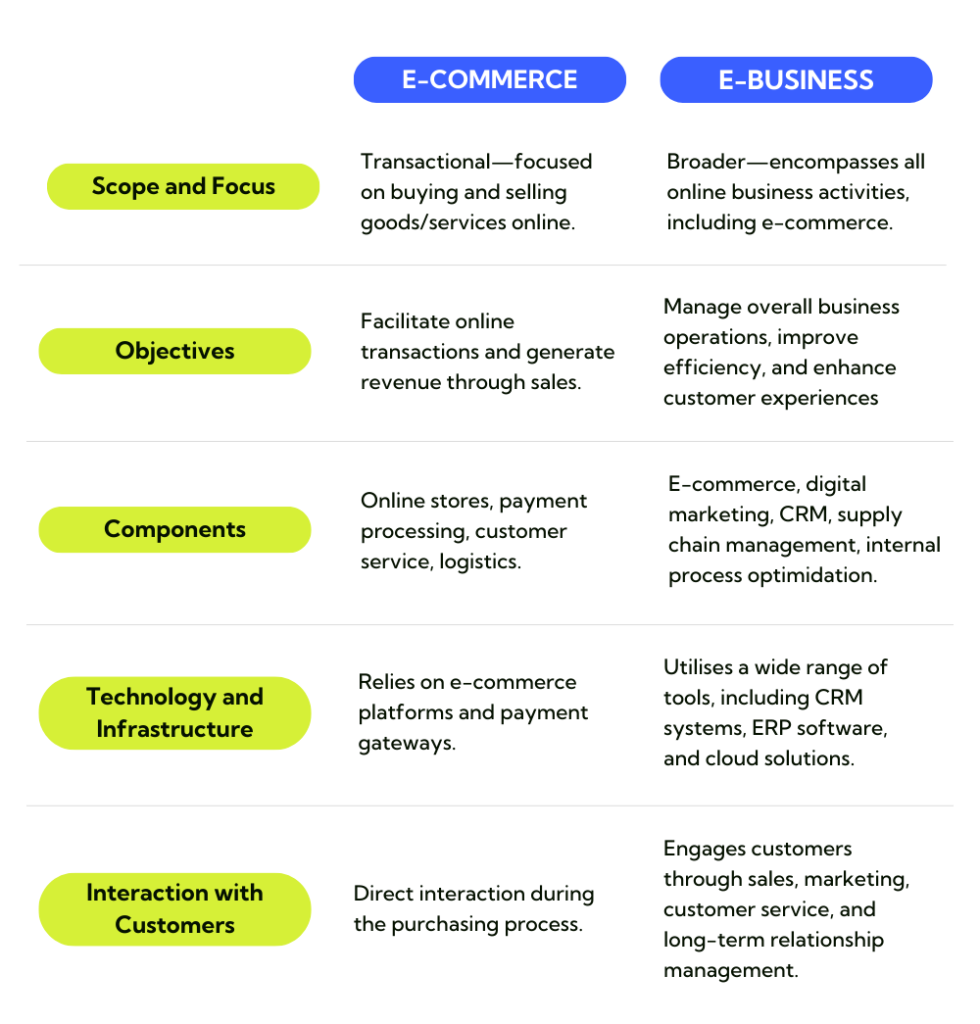E-Commerce vs. E-Business: Which Model Is Right for Your Digital Growth?

“e-commerce” and “e-business” are often used interchangeably. While they are closely related and frequently overlap, they are not the same thing. Understanding the differences between e-commerce and e-business is crucial for anyone involved in the online business world. Whether you’re a budding entrepreneur, a seasoned business owner, or someone interested in the digital economy, knowing how these two concepts differ—and how they work together—can significantly impact your strategy and success.
This comprehensive guide will break down the distinctions between e-commerce and e-business, explore their respective scopes, and explain why these differences matter. By the end of this article, you’ll have a clear understanding of each term, enabling you to make informed decisions that can boost your online business efforts.
Key Topics
What Is E-Commerce?
Definition and Scope of E-Commerce
E-commerce, short for electronic commerce, refers specifically to the buying and selling of goods and services over the internet. This includes everything from the online shopping experience to digital payment processing and customer service related to those transactions. Essentially, if you’re purchasing or selling a product or service online, you’re participating in e-commerce.
Key Components of E-Commerce
To fully understand e-commerce, let’s break down its key components:
- Online Stores: This is the most visible aspect of e-commerce. Websites like Amazon, eBay, and Shopify are prime examples of e-commerce platforms where businesses list their products for customers to purchase online.
- Digital Payment Processing: For an e-commerce transaction to be completed, payment must be processed electronically. This includes credit card transactions, digital wallets like PayPal, and newer methods like cryptocurrency.
- Customer Service: E-commerce also encompasses the support services offered to customers after they make a purchase. This can include anything from answering product questions before the sale to handling returns and refunds afterward.
- Logistics and Delivery: Another crucial aspect of e-commerce is the fulfillment of orders. This involves the logistics of shipping products to customers, whether through postal services, courier companies, or even drone delivery in some cases.
Types of E-Commerce
E-commerce can be further divided into several categories based on the nature of transactions:
- Business-to-Consumer (B2C): This is the most common form of e-commerce, where businesses sell directly to consumers. Examples include online retailers like Amazon and fashion brands with their own websites.
- Business-to-Business (B2B): In this model, transactions occur between businesses. For instance, a wholesaler might sell goods to a retailer via an online platform.
- Consumer-to-Consumer (C2C): Platforms like eBay and Craigslist allow consumers to sell directly to each other. These transactions are typically facilitated by third-party platforms that take a commission on each sale.
- Consumer-to-Business (C2B): In this less common model, individuals sell products or services to businesses. Freelance platforms like Upwork, where individuals offer services to companies, are a good example.
Advantages of E-Commerce
E-commerce offers several benefits that have made it a dominant force in global trade:
- Global Reach: Unlike traditional brick-and-mortar stores, e-commerce businesses can reach customers all over the world, breaking down geographical barriers.
- Convenience: Consumers can shop 24/7 from the comfort of their homes, making it a more convenient option than in-person shopping.
- Lower Operational Costs: Running an online store generally costs less than maintaining a physical storefront. This includes savings on rent, utilities, and sometimes even staff.
- Personalisation and Targeted Marketing: E-commerce platforms can track customer behaviour and preferences, allowing businesses to personalise marketing efforts and recommend products more effectively.
- Data and Analytics: E-commerce businesses have access to vast amounts of data, from customer demographics to purchasing habits, enabling them to make informed business decisions.
What Is E-Business?
Definition and Scope of E-Business
While e-commerce focuses specifically on the transaction of goods and services online, e-business (electronic business) encompasses a broader range of business activities conducted over the internet. E-business involves not just buying and selling but also the entire process of managing an online business. This includes everything from digital marketing and supply chain management to customer relationship management (CRM) and beyond.
Key Components of E-Business
To grasp the full scope of e-business, it’s important to understand its various components:
- E-Commerce: As mentioned earlier, e-commerce is actually a subset of e-business. It’s the transactional component of e-business, where goods and services are bought and sold online.
- Digital Marketing: E-businesses engage in digital marketing strategies to attract and retain customers. This includes SEO (search engine optimisation), pay-per-click marketing, email campaigns, and content marketing.
- Supply Chain Management: E-business involves managing the flow of goods, information, and finances throughout the supply chain. This can include everything from sourcing raw materials to delivering the final product to the customer.
- Customer Relationship Management (CRM): Effective CRM systems are crucial for e-businesses, helping them manage customer interactions, improve customer satisfaction, and foster loyalty.
- Internal Processes: E-business also includes the digitalisation of internal processes, such as inventory management, employee communication, and data analysis. These processes are streamlined through the use of software and online tools, making businesses more efficient.
- Collaborations and Partnerships: E-business often involves collaborating with other companies, suppliers, and service providers to create a seamless online operation. This can include partnerships with logistics companies, payment processors, and technology providers.
The Broader Impact of E-Business
E-business has a far-reaching impact beyond just selling products. Here’s how it influences various aspects of a company’s operations:
- Operational Efficiency: By integrating various business processes online, e-businesses can operate more efficiently. This includes automating routine tasks, improving communication across departments, and reducing the time and cost associated with manual processes.
- Enhanced Customer Experience: E-businesses can provide a more personalised and responsive experience to customers. With the help of CRM systems and data analytics, businesses can tailor their offerings to meet customer needs more precisely.
- Scalability: E-business models are inherently scalable. As businesses grow, they can easily expand their digital operations to accommodate more customers, products, and services without the limitations of physical infrastructure.
- Innovation and Flexibility: E-business allows companies to be more innovative and flexible in their approach. Whether it’s launching new products, entering new markets, or adopting new technologies, e-businesses can pivot quickly to stay ahead of the competition.
Types of E-Business Models
E-business can be categorised into several models based on how companies use the internet to conduct their operations:
- Pure-Play E-Business: These are businesses that operate entirely online without any physical presence. Examples include digital services like Netflix, or online-only retailers like ASOS.
- Bricks-and-Clicks: This model combines online and offline operations. Traditional retailers like Walmart or Best Buy fall into this category, as they offer both physical stores and an online shopping experience.
- Online Marketplaces: Platforms like Amazon and Alibaba operate as online marketplaces, facilitating transactions between buyers and sellers. These companies provide the infrastructure and services needed for other businesses to sell online.
- SaaS (Software as a Service): SaaS companies provide software solutions over the internet. Examples include Salesforce for CRM, Slack for communication, and Shopify for e-commerce platforms.
The Intersection of E-Commerce and E-Business
While e-commerce and e-business are distinct, they are closely related and often intersect in practice. E-commerce is a critical component of e-business, but e-business encompasses much more than just online sales. Understanding how these two concepts interact can help businesses create more comprehensive and effective strategies.
Key Differences Between E-Commerce and E-Business

Why Understanding the Difference Matters
1. Strategic Decision-Making
Knowing whether you’re focused on e-commerce or e-business can help you make more informed strategic decisions. If your goal is purely to sell products online, you might prioritise building a robust e-commerce platform. However, if you’re looking to optimise all aspects of your online operations, you’ll need to consider a broader e-business strategy.
2. Resource Allocation
Understanding the difference between e-commerce and e-business can also guide how you allocate resources. E-commerce might require investments in website development, payment processing, and logistics. E-business, on the other hand, may necessitate additional investments in CRM systems, digital marketing tools, and supply chain management.
3. Customer Experience
E-business offers more opportunities to enhance the customer experience beyond just the point of sale. By integrating CRM systems, personalising marketing efforts, and optimising customer service, e-businesses can build stronger, longer-lasting relationships with their customers.
4. Competitive Advantage
Businesses that understand and effectively implement e-business strategies often gain a competitive advantage. They can operate more efficiently, adapt more quickly to market changes, and provide a more comprehensive customer experience compared to businesses that focus solely on e-commerce.
5. Scalability and Growth
E-business models are generally more scalable than e-commerce models alone. As your business grows, an e-business approach allows you to expand your operations smoothly, integrate new technologies, and enter new markets without significant disruptions.
Practical Applications and Examples
To better illustrate the differences and intersections between e-commerce and e-business, let’s look at a few real-world examples:
Amazon: The E-Business Giant
Amazon started as an e-commerce platform selling books online. However, it quickly expanded into a full-fledged e-business. Today, Amazon’s operations include not just online sales but also cloud computing (Amazon Web Services), digital streaming, logistics, and more. Amazon’s e-business strategy integrates various aspects of online operations, making it one of the most successful companies in the world.
Shopify: Empowering E-Commerce
Shopify is a platform that enables businesses to set up their own online stores, making it a key player in the e-commerce space. While Shopify itself is an e-business (providing SaaS), its primary focus is on empowering e-commerce by offering tools for building and managing online stores. Shopify merchants use the platform for transactions, but their broader business operations might include other e-business activities like marketing and CRM.
Netflix: A Pure-Play E-Business
Netflix operates entirely online, with no physical stores or products. It’s a pure-play e-business that offers digital streaming services. Netflix’s business model includes subscription management, content recommendation systems (driven by data analytics), and global content delivery networks. All these aspects make Netflix an e-business rather than just an e-commerce platform.
Zara: The Bricks-and-Clicks Model
Zara, a global fashion retailer, operates both online and offline, making it an example of the bricks-and-clicks model. Zara’s e-commerce site allows customers to purchase products online, while its physical stores provide an in-person shopping experience. However, Zara’s e-business strategy includes inventory management, supply chain optimisation, and data-driven marketing, all of which are integrated across its online and offline operations.
How to Choose Between E-Commerce and E-Business
1. Evaluate Your Business Goals
Start by considering your primary business objectives:
- If your main goal is to sell products online and generate revenue through direct transactions, an e-commerce approach might be sufficient. E-commerce is ideal for businesses that want to focus on sales without getting too involved in other aspects of online operations.
- If you aim to create a more comprehensive online presence that includes marketing, customer relationship management, and operational efficiency, then an e-business model is more appropriate. E-business allows you to integrate various aspects of your business into a cohesive digital strategy, which can lead to long-term growth and scalability.
2. Assess Your Resources
Next, take stock of your current resources, including time, budget, and expertise:
- For businesses with limited resources, focusing on e-commerce can be more manageable. Setting up an online store, managing transactions, and handling logistics are straightforward compared to the broader scope of e-business.
- If you have the resources to invest in technology, marketing, and customer management systems, transitioning to an e-business model can offer greater returns. E-business requires a broader range of tools and platforms, but these investments can lead to improved efficiency, customer loyalty, and business growth.
3. Consider Your Market and Industry
The nature of your market and industry can also influence your decision:
- In highly competitive markets where customers value convenience and speed, focusing on e-commerce might be the best strategy. A streamlined, efficient e-commerce platform can help you compete by offering a superior shopping experience.
- If your industry benefits from strong customer relationships, personalised service, and complex supply chains, an e-business approach might be more suitable. E-business strategies allow you to build deeper connections with your customers and manage more intricate operations effectively.
4. Think About Scalability
Your long-term plans for growth should also play a role in your decision:
- If your primary focus is on scaling your sales operations quickly, e-commerce provides a straightforward path. You can easily expand your product offerings, target new markets, and increase revenue through online sales channels.
- If you envision scaling your business by improving operational efficiency, expanding your digital marketing efforts, and enhancing customer relationships, an e-business model will better support these goals. E-business strategies are inherently scalable, allowing you to grow various aspects of your business in tandem.
5. Evaluate Your Technical Capabilities
Your technical capabilities and comfort with digital tools are crucial factors:
- If you or your team have limited technical expertise, starting with an e-commerce platform that’s easy to set up and manage might be the best option. Many e-commerce platforms, like Shopify or WooCommerce, offer user-friendly interfaces that don’t require extensive technical knowledge.
- If you have access to technical expertise or are willing to invest in learning and development, an e-business approach can unlock more advanced opportunities. Implementing CRM systems, integrating marketing automation tools, and optimising internal processes require a higher level of technical skill but offer significant advantages.
6. Hybrid Approach: Blending E-Commerce and E-Business
Remember, you don’t have to choose one over the other. Many successful companies start with e-commerce and gradually evolve into e-businesses as they grow. This hybrid approach allows you to begin by focusing on sales and then expand into other areas as your business matures and your resources increase.
- Start with E-Commerce: Launch your online store, establish your brand, and begin generating revenue through online sales.
- Expand to E-Business: As your business grows, start incorporating e-business strategies like digital marketing, CRM, and supply chain management to build a more robust and efficient operation.
Making the Right Choice
Choosing between e-commerce and e-business ultimately comes down to your specific needs, goals, and resources. By carefully evaluating where you are now and where you want to be in the future, you can select the approach that aligns best with your vision for success. Whether you’re starting small with e-commerce or ready to embrace the full scope of e-business, the key is to remain flexible and open to growth.




